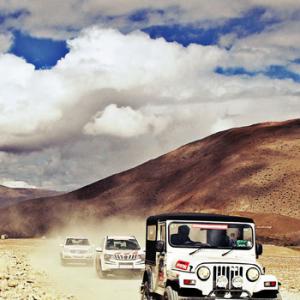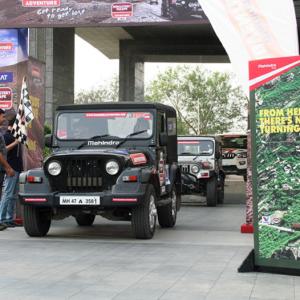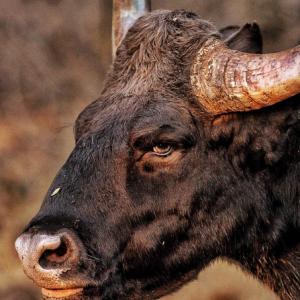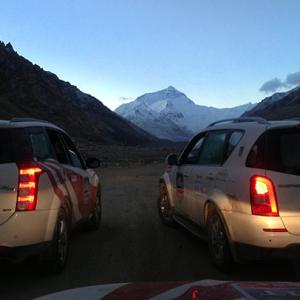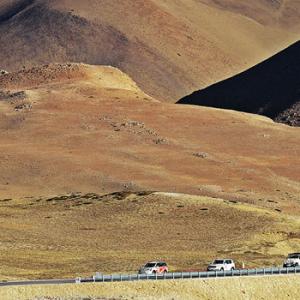Not your average daily drive at all :)
↑
A ten-day drive, across three of India's jewels -- the spectacularly beautiful North-Eastern states of Assam, Arunachal Pradesh and Meghalaya -- became an expedition that was ONLY about the journey. And not about reaching a destination.
Photograph: Milind Kale/Mahindra Adventure
Driving in a convoy of 20 sturdy SUVs across some of the remotest areas of our country -- through forests, past mountain villages and army camps -- has unexpected highs.
Like learning the discipline of driving safely in a convoy.
Or the thrill and drama of making a road stop -- 20 vehicles in unison getting off the highway and then back on...
On the first leg of a 1,800 km, 10-day journey across three North-Eastern states, Rediff.com's Rajesh Karkera drives almost 400 bumpy, dusty, kilometres north from Assam into Dirang, a sleepy little town in West Kameng district, Arunachal Pradesh, on the lower slopes of the Himalayas.
Planning an epic road trip?
Don't bring your car!
Huh? Did you hear right?
Yup. There is probably just one road expedition, offered in India, for which you don't need to bring your own four-wheel drive vehicle.
It is also an expedition that's really about the journey.
And not about reaching a destination.
Run by Mahindra Adventures, this excursion took us on a lovely drive through Assam, Arunachal Pradesh and Meghalaya, three of the bewitching Seven Sister States that I have dreamed of driving across...
You know, bucket list kind of stuff for us open-road-starved Mumbaikars.
A morning pow-wow and prayers, before taking off, was a ritual that was taken seriously.
Photograph: Rajesh Karkera/Rediff.com
Imagine a chance to cruise down the highways from Guwahati.
Climb to Dirang in Arunachal.
Wind your way up the curving roads to mesmerising Tawang, crossing a height of 13,700 feet above sea level at Sela Pass, on the second-highest motorable road in the world.
Coasting down to the rhino-rich jungles of Kaziranga.
And then onto beautiful, tranquil Shillong to explore the mysterious living root bridges, deep inside Meghalaya, before making a U-turn back for Guwahati.
Not your average daily drive at all ;)
This is the white XUV500 4WD we drove on the first leg, from Guwahati, Assam, to Dirang, Arunachal Pradesh across 400 km.
Photograph: Rajesh Karkera/Rediff.com
First Leg: Guwahati to Dirang, 385 km, 10 hours of driving, plus rest stops
We started off from Guwahati at 6 am -- and all I thought was: Wow! Driving in a convoy, yay!
There was no other thought.
No expectations.
No concern about the kind of facilities, the food, the drinks or the stay.
I had no idea who my fellow travellers would be either.
Or what kind of a car I would be driving.
All I knew was that this was not just any road trip.
It was an expedition.
There was a simple, raw beauty to the countryside we drove through. And what smiles! Everyone stopped to beam and wave at our convoy!
Photograph: Rajesh Karkera/Rediff.com
The organisers did warn us not to be driven by the urge to overtake other cars in the convoy.
Or make unscheduled stops.
And to keep up with the convoy, no matter how fast or slow it was going.
When we reached the parking lot, that morning, at dawn, we met the Mahindra team -- all very helpful, especially Vinod Nookala, brand manager for Mahindra's Thar, and the core members of Mahindra Adventures -- and I was allowed to choose the vehicle I would drive.
I thought I would opt for the new Scorpio 4x4 S10. But instead picked the new XUV500 4WD which guarantees a smoother drive.
I didn't really want to rough it out from the beginning. I wasn't sure how the roads would be.
They said there would be patches where the road would entirely disappear, just a dirt track... Whoa!
The convoy followed a single line, always on one side of the road.
Photograph: Rajesh Karkera/Rediff.com
The start was amazing.
Imagine 20 cars driving together.
A Mahindra Thar was the lead vehicle of the convoy. In its trail followed 16 Scorpios (!) and three XUV500s.
This was unlike any drive I had done before -- I'm 42 now and have been driving since I was 16!
Right from the start there is an itch to overtake or stop. But you can't.
Should you need to make a halt you have to inform the convoy over the VHF radio, provided in each car.
Only if the lead car allowed you to stop, could you stop.
Else you just kept going...
If you had no option but to stop, one of the cars in the convoy, deemed the float or the sweep, would come abreast and wait to see that all was safe and ensure you joined the convoy as soon as you were ready to get back on the road.
We were told the good roads would disappear just about 150 km into the drive.
We needed to make the most of it and cover as much distance in the first couple of hours.
Hence, we started out with just tea and biscuits and a packed breakfast of boiled eggs, croissants and muffins to eat along the way.
The much-needed tea break, after a 2.5 hours non-stop drive, afforded a little bit of chilling time and photographs.
Photograph: Rajesh Karkera/Rediff.com
Our first stop was more than two hours later for tea at 8.40 am for 20 minutes.
It is not an easy task for 20 cars to stop at the same rest stop and be on the road again, all at the same time. But the Mahindra Adventures team excels at getting an entire convoy back on the road at the exact estimated time.
Driving ahead to the next stop at 11 was bliss. This is a driving experience that can't happen if you are driving alone.
There's no need to worry about logistics at all.
You need to follow the rules of the team leader and just drive, while enjoying the pleasure of driving a fully loaded car (packed with top-end features).
Crossing bridges was a thrill! The dramatic rumble the convoy made as it it bumped across bridges was an exciting sound.
Photograph: Rajesh Karkera/Rediff.com
After the first two hours of flat unending tarmac, the broken roads were actually a welcome change. That's where the cars showed their mettle.
My XUV500, which was a dream to drive on the tarmac, did take a beating on the pothole-ridden stretches.
I felt sad for the vehicle because I couldn't slow down.
Speed had to be maintained -- even if it punished the car -- to keep abreast with the rest of the convoy.
If one car slowed down, the others behind suffered.
The landscape began to change 150 km into the drive. We were soon greeted by green mountains and bamboo homes.
Photograph: Rajesh Karkera/Rediff.com
The lunch break at 11, after covering half the drive (226 km) was inside the Nameri Forest Reserve at an eco camp run by the Assam Bhorelli Angling and Conservation Association.
It was a lavish spread: Rotis, three different types of sabzis, dal, some wonderfully cooked local gravy chicken and the full range of Assam's interesting pickles, followed by a chotta round of leisure, to catch a quick nap or play football inside the clean and green camp.
.
Nameri Eco Camp, where we had our lunch before we exited Assam, is a very beautiful property admist a lush green forest.
Photograph: Rajesh Karkera/Rediff.com
We were back on that road at 12:35pm, after a roll call over the VHF radio... "Adventure 1 rolling.. Adventure 2 rolling..."
Every participant just loved to say that over the radio... :)
At one point our car, Media 2's radio broke down. It was replaced by the service team at the next scheduled rest stop.
Meanwhile the other cars saw to it that important information coming on the radio was somehow conveyed to us till we reached the rest stop. Team spirit!.
Shanti, who works in the eco camp, was happy to answer all our queries about the local fruit and pickles on sale. She hails from the nearby village of Potasali, half a kilometre away.
Photograph: Rajesh Karkera/Rediff.com
This drive onwards from Nameri was full of unexpected sights and unparalleled scenery.
School children everywhere waved at us roadies.
Older folks stopped in their tracks to observe us with curiosity.
Families came out of their homes to watch our convoy pass as if we were some hot-shot VIPs.
Quite a heady feeling.
Children were both surprised and delighted to see our convoy pass.
Photograph: Rajesh Karkera/Rediff.com
As we drove through the broken patches of road, they threw up dust, which flew up onto the car ahead and created a kind of dust storm that brought visibility down to almost nil.
It required very attentive driving and your eyes firmly on the car ahead.
What helped most were the tail lights. We moved with the headlights and taillights on throughout the journey. It assisted in recognising the cars, especially when you had to slow down because of bad roads and dust.
'Bio breaks' were hard to come by. Especially through stretches of just dust and landslides. Mahindra did a good job of cordoning off areas for everyone (including women participants) to get their respective breaks; all were equal on this trip, no men no women, just drivers, all team-mates.
The dust kicked up by the convoy made me wonder about its impact on the health of the locals who live at the edge of these uneven roads.
Photograph: Rajesh Karkera/Rediff.com
At 4.38 pm came Tenga. And a much needed break, whew!
Evening tea at an army camp. There were so many muffins and croissants leftover in our SUVs. But it was tea and coffee that everyone made a beeline for.
Here we found the first working ATM machine with just four people in the queue; don't forget we were making a journey in the first days of demonetisation. Happiness!
Journey breaks were happy moments.
Photograph: Rajesh Karkera/Rediff.com
Darkness comes early in the North-East.
By 5 pm the sun was down, as the convoy rolled towards Norphel retreat in Dirang, where we were scheduled to spend the night.
The stretch till Dirang made me quite queasy.
The roads were winding and perhaps our bodies were just taking time to get used to the altitude.
Surprisingly it was just 4,910 feet above sea level and I have travelled to higher altitudes and not experienced this. It could be because of the biting cold temperatures too
VIDEO: An authentic North-East driving expedition: Guwahati, Assam to Dirang, Arunachal.
At 7 pm, as we were approaching the night halt destination, we had to refuel.
It's a rule that every car refuels before calling it a night to prevent slow morning starts.
Twenty cars, of course, take 35 minutes to refuel!. Seemed like a lifetime.
And then we were back on the road for the final stretch, climbing in pitch darkness towards our day's destination.
At 8 pm we had the first joyful glimpse of the location of our overnight stop. Seemed like we were approaching a monastery.
The Norphel Retreat looks exactly like one. It was huge and colourful, even in the darkness.
Norphel Retreal, Dirang, has a largely all-women staff. The men were only in the kitchen :)
Photograph: Rajesh Karkera/Rediff.com
The staff at the Norphel Retreal, Dirang, all women, greeted us, wrapping yellow silk stoles around our necks.
"Where are the men?" I thought to myself as the women took our bags. We felt uncomfortable.
My co-driver Siddharth and I decided to take our own bags. But they were adamant.
It seemed the hotel was mostly manned by women.
Norphel Retreat had an enormous reception lobby, adorned with Tibetan motifs! What a grand sight.
Nausea ensured that I sadly had to give dinner a miss. But tomorrow promised to be an even more exciting day.
- Leg 1: Guwahati to Dirang, 385 km, 10 hours of driving, plus rest stops
- Leg 2: Dirang, to Tawang, 135 km, 5 hours of driving, plus stops
- Leg 3: Tawang to Dirang, 135 km, 6.5 hours of driving plus rest stops
- Leg 4: Dirang to Kaziranga, 272 km, 7.5 hours of driving, plus rest stops
- Leg 5: Kaziranga to Shillong, 307 km, 7 hours of driving, plus rest stops, and back to Guwahati, 105 km, 2.5 hours driving, plus rest stops
First Leg: Route map


